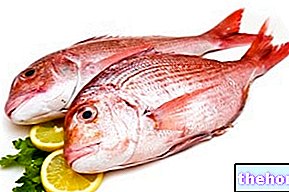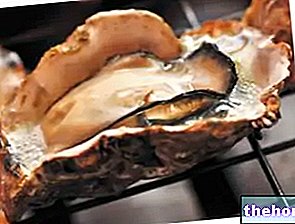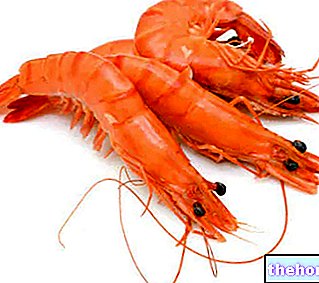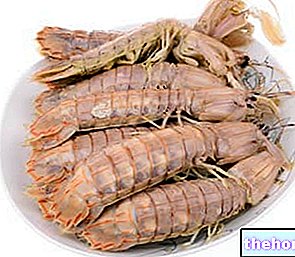A fish defines itself fresh when it has just been fished and has not undergone chemical-physical processing or treatments to prolong its conservation (separate evisceration); it follows that defrosted fish and not duly INDICATED as such, if passed off as fresh (in order to distinguish it from the preserved one), constitutes a potential commercial fraud.
![]()
METHODS to recognize fresh fish from spoiled ones
Sensory method: applicable without the use of equipment or chemical reagents; in summary:
Part of the fish
Positive features
Negative characteristics
General appearance
Brilliant, metallic, iridescent
Dull, dull
Body
All "purchase must have a certain rigidity (rigor-mortis), which lasts for at least 6-7 hours
Soft, flabby
Skin and scales
It must be moist, shiny, shiny and taut, with very adherent scales and rich in transparent mucus
Colorful, tearing, pigmented with milky and opaque mucus, scales that are easily removed
Meat
They must be bright in color, firm, elastic (subjected to pressure with the finger, they must immediately return to shape)
Flabby, with yellowish edges, grainy and opaque surface, easily flaking
Eye
It must be very lively, bright, rounded, turgid and not hollowed out
Risen, opaque, sunken with gray pupil
Gills
They must be well closed, with red or pink gills, moist with transparent mucus
Raised, yellowish, grayish or brick red, with milky or dry mucus
Vertebral column
It must be clear, colorless and resistant, difficult to break; moreover it must be very adherent to the flesh
Not adherent to the flesh, red in color
Belly
Elastic, stain-free, compact
Swollen, flabby
Viscera
Smooth, clean and shiny
Soft, swollen and with a putrescent smell even without piercing the intestines
Anus
Locked down
Lasso and bulging
Smell
Inviting, soft and pleasant; if it is sea fish, brackish and seaweed
Acre, ammoniacal and tending to acid
METHODS to recognize whole and healthy fish (even if thawed) from spoiled fish
In theory, a fish duly treated with cold, then blast chilled and frozen, preserves most of the organoleptic characteristics of fresh fish (but not all! Blue fish, for example, suffers more than others). A defrosted fish, compared to a fresh fish, loses muscle tone, luster of the skin and redness of the gills ... but does not remain compromised in terms of healthiness; everything else! The lowering of temperature is therefore an ESSENTIAL procedure for the consumption of raw fish, since it destroys parasites such as anisakis (even if it does not reduce the bacterial load); on the other hand, by subjecting a fish to cooking, the biological and microbiological risk is reduced regardless of the killing; this means that, being able to choose between a "fresh" fish and a defrosted one, from an organoleptic point of view, when cooked the first will certainly be more pleasant than the second. Fresh fish, however, cannot and should not be eaten raw; the raw foodist should therefore turn to fish that have been thermally chilled according to the laws in force (temperatures of -20 ° C for at least 24 hours).
Given the scarce availability of fresh fish from the short supply chain, global consumption is increasingly converging towards deep-frozen and frozen products, to be defrosted or already defrosted; for this reason, the control bodies have techniques and means capable of assessing the integrity of the fish, but with a minimum of attention and experience even retail consumers can avoid the one that is damaged or simply in a precarious state of conservation.
For consumers, the measures are essentially the same as those listed for fresh fish (with the precaution of what is mentioned in the previous paragraph), while the control bodies are able to use other standardized and safer methods, since they are based on scientific parameters. :
Physical method: determination of the electrical conductivity of the fabrics: as the fresh product deteriorates, the electrical conductivity increases. Requires special instrumentation.
Chemical method: determination of the trimethylamine, volatile basic nitrogen, formaldehyde, histamine, peroxides and thiobarbituric acid. Special instrumentation is required.
Biochemical method: search for specific enzymes that escape from the cells during thawing; if they are present, it means that the fish has been frozen and refrozen. Requires special instrumentation.
Microbiological method: is based on the development of microorganism cultures, but they are too long to be applied to the instant assessment of fish. Requires special instrumentation.
Tuna carpaccio
Problems with playing the video? Reload the video from youtube.
- Go to the Video Page
- Go to the Video Recipes Section
- Watch the video on youtube
Indications for consumers of fresh or defrosted fish
Fresh: we remind buyers of fresh fish that food "chemistry" works wonders! Some substances, improperly applied to almost spoiled fish, can deceive the senses of an unscrupulous or simply unlucky consumer. Certain "unprofessional" suppliers sprinkle the steaks with nitrates and nitrites and give them bluefin tuna, in order to preserve their ruby color (as in a butcher's shop), even if sometimes the result can be counterproductive; it will have happened to everyone to notice slices of tuna on the counters that from red-brown (natural color and also dependent on the bleeding process of the animal) take on a bright fuchsia color and decidedly unnatural. In other cases the fish comes in large packs full of ice, which while deceiving the sight, do not hide the smell of ammonia (shellfish, having a shell, are particularly suitable for scams as they retain the smell from raw and relentlessly release it during cooking).
Frozen or frozen: when buying frozen fish it is necessary to remember that the cold chain must be kept unbroken, therefore uninterrupted; for this purpose, it is advisable to put the frozen fish in the cart only AT THE ULTIMATE EXPENSE and to preserve its temperature using refrigerated bags or thermal bags specially integrated with frozen eutectic plates (siberino). Then, after having monitored the temperature indicated in the thermostats of the refrigerated cabinet and having arrived at the choice of the package, priority will be given to the frozen / frozen products on the BOTTOM of the freezer as they are less subject to thermal changes caused by the opening of the hatch.
NB. The seriousness of a supermarket is also assessed on the basis of the position of the frozen food counter, which must be close to the checkout counters and on the opposite side from the entrance.
NB. The EEC has established a classification, n. 2455/70, art. 6, which provides for the subdivision of fish based on the state of conservation; see the dedicated article: Pisces - classification and structure.
Fish, Molluscs, Crustaceans Anchovies or Anchovies Garfish Alaccia Eel Lobster Herring Lobster Whitebait Bottarga Sea bass (Sea bass) Squid Canocchie Scallops Canestrelli (Sea scallops) Capitone Caviar Mullet Monkfish (Monkfish) Mussels Crustaceans Dates Sea Fruits Fish Flour Fauna Fish stock Prawns Crabs Spider crab (Granceola) Halibut Sea salad Lanzardo Leccia Sea snails Prawns Cod Molluscs Octopus Hake Ombrina Oysters Sea bream Bonito Pangasius Paranza Anchovy paste Fresh seasonal fish Blue fish Puffer fish Swordfish Plaice Octopus (Octopus) Hedgehog of Sea Amberjack Salmon Sardines Sardines Scampi Cuttlefish Mackerel Sole Stockfish Surimi Sushi Telline Tuna Canned tuna Mullet Trout Fish roe Bluefish Clams OTHER FISH ARTICLES Categories Alcoholic Food Meat Cereals and derivatives Sweeteners Sweets Offal Fruit Dried fruit Milk and derivatives Legumes Oils and fats Fish andpeach products Salami Spices Vegetables Health recipes Appetizers Bread, Pizza and Brioche First courses Second courses Vegetables and Salads Sweets and Desserts Ice creams and sorbets Syrups, liqueurs and grappa Basic preparations ---- In the kitchen with leftovers Carnival recipes Christmas Light diet recipes Women's, mom's and dad's day recipes Functional recipes International recipes Easter recipes Celiac recipes Diabetic recipes Holiday recipes Valentine's Day recipes Vegetarian recipes Protein recipes Regional recipes Vegan recipes




























